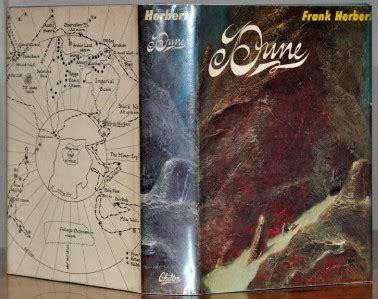If you want to know if a Dune book is a first edition, there are several ways to tell. First editions of Frank Herbert’s classic science fiction novel were published in 1965 by Chilton Books. Here are some tips on how to identify a first edition.
The most obvious indicator of a first edition is the copyright page. The first edition of Dune was published in the United States and the copyright page will say First Chilton Books Edition: 1965. Additionally, the first printing of the book had a black and cream dust jacket with a price of $3.95.
The text on the spine of the dust jacket should also be checked. First editions of Dune have the word First printed in the bottom right corner of the spine. This indicates that it is a first edition.
The type of paper the book is printed on can also be an indicator of a first edition. The first edition of Dune was printed on a thicker, off-white paper, known as Bible paper, while later printings used lighter paper. The texture of the paper will be noticeably different if it is a first edition.
Finally, the book should be examined for errors. The first edition of Dune contains several typos, including missing words and incorrect word spellings. These errors were corrected in later editions and can be a good indicator of a first edition.
In summary, if you want to know if a Dune book is a first edition, you should look for the copyright date, the word First printed on the spine, the type of paper used, and any typos in the text. With these tips, you can easily identify a first edition of Dune.
Identifying A First Edition Dune
Dune is a classic science fiction novel by Frank Herbert, first published in 1965. It is considered one of the most influential works of the genre and has spawned many sequels and adaptations. If you’re looking to collect first editions of Dune, it’s important to know how to identify a true first edition.
The most reliable way to identify a true first edition of Dune is to check the copyright page. This page will usually contain the publisher’s name and the year of publication. The first edition of Dune was published by Chilton Book Company in 1965. Any book published before this date can’t be a first edition. The copyright page is also likely to include the words “First Edition” or “1st Edition”, although this isn’t always the case. Other clues to look for in the copyright page are the number of printings or editions, and the library of congress number.
It’s also important to pay close attention to the condition of the book. A first edition of Dune should be in near mint condition. Any signs of wear and tear or damage to the binding could indicate that the book is not a first edition. Check for any writing or highlighting on the pages as well, as these could also be indicators that the book is not a first edition.
Finally, the price of a first edition of Dune should be taken into consideration. First editions of Dune can be extremely valuable and are highly sought after by collectors. A true first edition should be priced accordingly. Prices can range from several hundred dollars to thousands of dollars, depending on the condition of the book.
Identifying a first edition of Dune can be a difficult task, but with the right information and a little bit of research, it is possible. Once you have identified a true first edition, you can be sure that your copy of Dune will become a valuable addition to your collection.
How To Spot A First Edition Dune
Are you looking to determine if you have a first edition of Dune? Knowing how to spot a first edition of this classic science fiction novel is key to collecting the most valuable and sought after editions. In this article, we will look at the key features to help you identify a first edition Dune.
The first thing to look for when trying to differentiate a first edition Dune from a later edition is the dust jacket. A common feature among first edition Dune books is the presence of a “Ursula K. Le Guin” review. If the dust jacket includes this review, then it is likely that the book is a first edition. Additionally, first edition Dune books may also include a Lettered Edition which is printed in a very limited number of copies and usually comes with a special slipcase.
Next, you should take a look at the copyright page of the book. A first edition Dune book should include a copyright page that includes the words “Copyright 1966” and publisher “Chilton Book Company”. If the copyright page is missing, or the publisher listed is not Chilton, then it is likely not a first edition.
The binding of the book is also important when trying to identify a first edition Dune. A first edition Dune book should have the words “Publishers’ Edition” printed on the spine of the binding. Additionally, the binding should have the words “Dust Jacket Design” printed on the back cover.
Additionally, first edition Dune books are usually more expensive than later editions. A first edition Dune book can be valued at upwards of $2,000, while later editions may only be valued at around $50.
Finally, it is important to note that first edition Dune books are rare and highly sought after by collectors. They are often difficult to find and can be expensive. Therefore, it is important to do your research before making any purchases.
To summarize, first edition Dune books can be identified by the presence of a “Ursula K. Le Guin” review on the dust jacket, a copyright page with “Copyright 1966” and “Chilton Book Company” listed as the publisher, binding with “Publishers’ Edition” printed on the spine and “Dust Jacket Design” printed on the back cover. They are usually valued at a much higher price than later editions, and are often difficult to find.
| Features | Identifying Characteristics |
|---|---|
| Dust Jacket | “Ursula K. Le Guin” review |
| Copyright Page | “Copyright 1966”, “Chilton Book Company” |
| Binding | “Publishers’ Edition” on spine, “Dust Jacket Design” on back cover |
| Price | At least $2,000 |
A first edition Dune book would have a first edition printing notice, the author’s name on the title page, and the publisher’s name and address on the copyright page.
To identify a first edition Dune, look for the first edition printing notice, the author’s name on the title page, and the publisher’s name and address on the copyright page.
The cover of a first edition Dune would not have any indication that it is a first edition. Instead, look for the first edition printing notice inside the book, the author’s name on the title page, and the publisher’s name and address on the copyright page.
No, there are no other noticeable features on the cover of a first edition Dune. Instead, look for the first edition printing notice inside the book, the author’s name on the title page, and the publisher’s name and address on the copyright page.
Look for a First Edition printing notice, usually located on the copyright page of the book.
Look for the author’s name on the title page of a first edition Dune.
Check the publisher’s name and address on the copyright page of the book to make sure it matches the publisher listed on the first edition printing notice.
Yes, consider the condition of the book, its age, and the edition number printed on the copyright page.
Look for specific details, such as the author’s name on the title page, the printing notice on the copyright page, and the publisher’s name and address on the copyright page.
If there are no printing notices, the author’s name is not printed on the title page, or the publisher’s name and address on the copyright page does not match the printing notice, then it’s not a first edition Dune.






